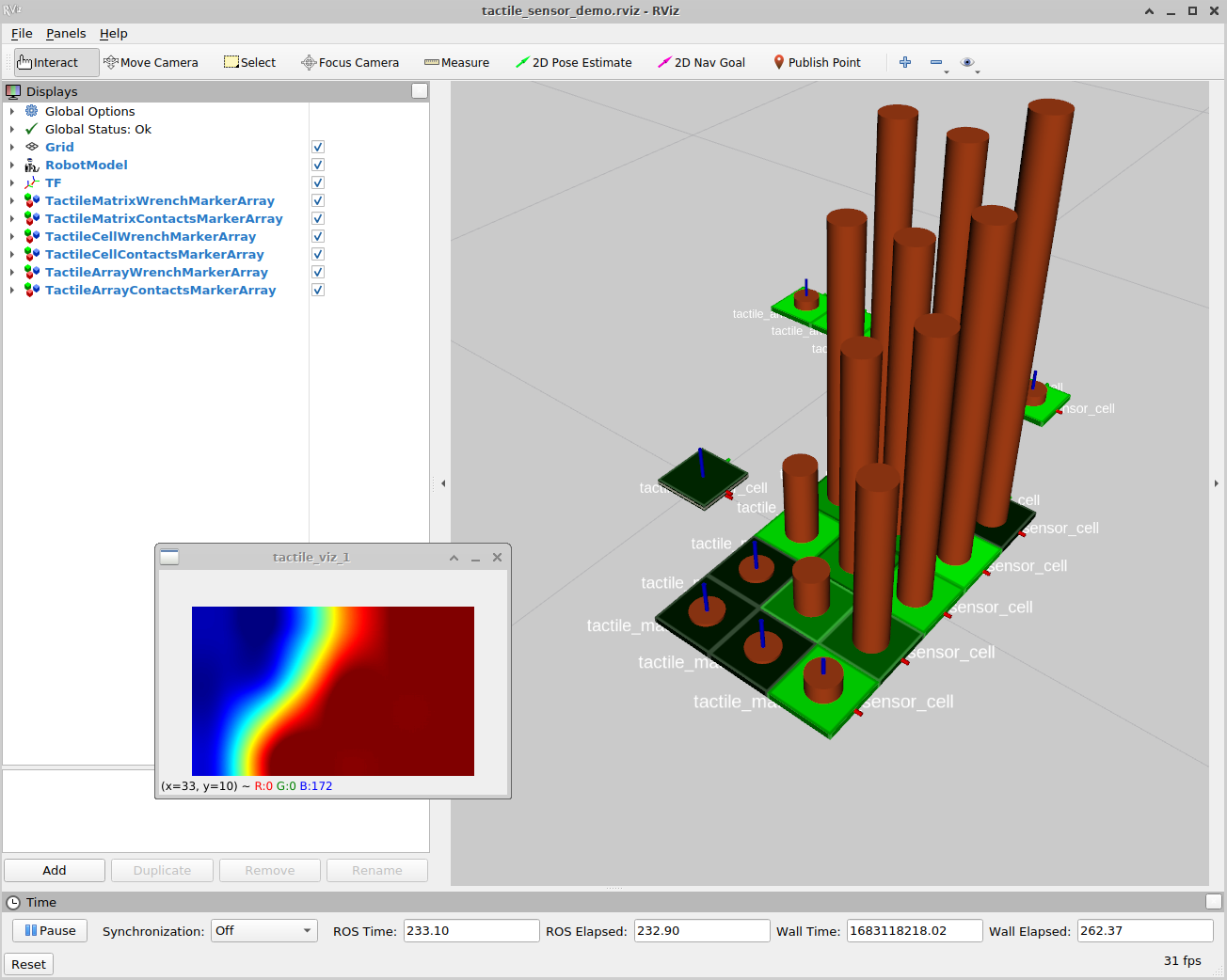This package provides Gazebo simulation models (URDF models) and visualization utilities for membrane-type tactile sensors. In particular, this package complements our low-cost flexible tactile sensors described in [3].
The corresponding software and hardware repositories are available at
- http://github.com/TAMS-Group/tams_tactile_sensor_array
- http://github.com/TAMS-Group/tams_tactile_sensor_hardware
The URDF model supports single sensor cells as well as 1-D (linear) and 2-D (matrix) arrays. The cell dimensions can be configured freely, but all cells are assumed to have the same size and orientation. Curved sensors are not supported directly, but can be approximated by polygonal alignment of 1xn and 1x1 individual sensors.
Each sensor cell is modeled as a small rectangle box that is mounted via a flexible joint to its parent component (e.g. a robot finger or the floor). The joint can be controlled if needed to guarantee a specific geometric configuration, but can also be left floating in the simulation.
To measure the incoming force on the sensor cell, two different mechanisms are configured. First, a force/torque sensor is connected to each sensor cell joint and configured as a ROS plugin that publishes geometry_msgs/WrenchStamped messages. That is, full 3-DOF force direction as well as 3-DOF effective torque is available from the simulator (while the real velostat foil sensors only provide normal force). Second, a contact/bumper sensor is connected to the sensor cell box, and again a ROS plugin is configured for this. The effective force is then calculated as the sum of the contribution of individual contacts listed in the gazebo_msgs/ContactsState message. Just uncomment the corresponding parts of the URDF model if you don't need one of the plugins, and keep the other one going.
Currently, only two simple ROS nodes are provided in this package. Both are implemented as Python scripts located in the nodes subdirectory:
-
tactile_sensor_visualizer subscribes to the Wrench and/or ContactsState messages, and first applies exponential averaging (smoothing) to the incoming data. It then creates MarkerArray messages for visualization in rviz.
-
tactile_sensor_proxy takes the same input messages, but creates a TactileSensorArrayData message that matches the output data from our real (Arduino+velostat foil) hardware sensors. It can therefore be used to test complete manipulation pipelines in simulation before application on the real system.
Simply clone the repository into your workspace and build your workspace. Make sure that all required dependencies, and in particular gazebo and tams_tactile_sensor_array, are installed and functional.
For a first test, run
roslaunch tams_tactile_sensor_array_gazebo tactile_sensor_gazebo.launch
This uploads a URDF file with three sensors onto the parameter server, then starts the Gazebo simulator and spawns the robot (=sensors) model. It also starts rviz for visualization of sensor data.
The demo model covers all three supported sensor types:
- a single cell (1x1) tactile sensor,
- a linear array sensor (1x6 cells),
- a matrix array sensor (5x3 cells).
Once the simulation is running, add additional objects (e.g. the Coke can, some boxes, or standing human) into your simulation and bring them onto the sensor(s). Don't hesistate to send email if you find a particularly interesting configuration.
To change node parameters at run-time, publish key+value strings to the various command topics:
rostopic pub -1 /tactile_cell_visualizer/command std_msgs/String "data: 'help'"
rostopic pub -1 /tactile_array_visualizer/command std_msgs/String "data: 'verbose 10'"
rostopic pub -1 /tactile_sensor_visualizer/command std_msgs/String "data: 'alpha 0.5'"
rostopic pub -1 /tactile_matrix1_proxy/command std_msgs/String "data: 'fscale -7.7'"
...
[1] http://github.com/TAMS-Group/tams_tactile_sensor_array [2] http://github.com/TAMS-Group/tams_tactile_sensor_hardware [3] Niklas Fiedler, Philipp Ruppel, Yannick Jonetzko, Norman Hendrich, Jianwei Zhang, Low-Cost Fabrication of Flexible Tactile Sensor Arrays, HardwareX, 2022. doi: 10.1016/j.ohx.2022.e00372

